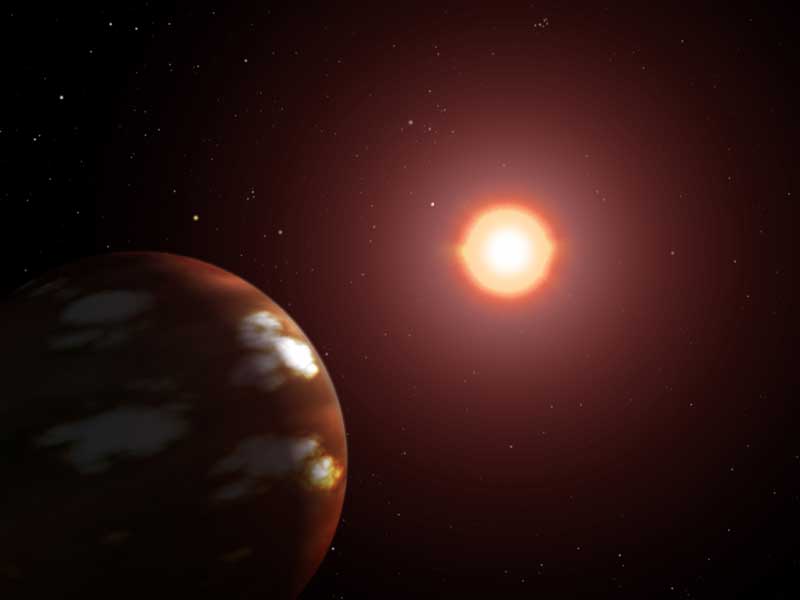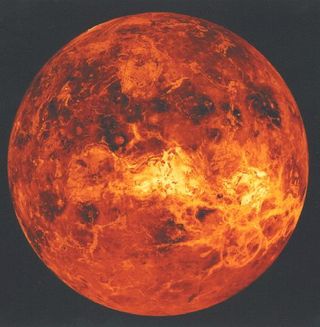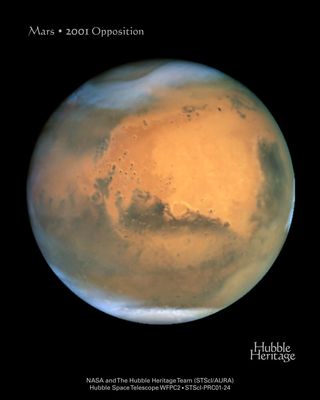Alien Planets With No Spin May Be Too Harsh for Life

Tidally-locked planets — planets with one side perpetually facing their star while the other remains shrouded in darkness — tend to be warmer on one side than the other. The presence of an atmosphere can help distribute the heat across the planet, equalizing the temperatures. But tidal locking could result in wide climate variations, a result that could threaten the evolution of life on the surface of these planets.
Tidal locking depends on the planet's mass and its distance from its star. For planets orbiting M-type stars, which are slightly smaller than our sun, the region where planets become tidally locked overlaps with the so-called habitable zone, where water can remain as a liquid on a planet’s surface.
In the solar system, the moon is tidally locked in orbit around Earth.
According to new research published in the December edition of the Astrophysical Journal,strong heating of a planet at a single point can change or even control how much weathering occurs on the planet, which can lead to significant and even unstable climate changes. These dramatic climate effects could make planets that otherwise have the potential for life to instead be uninhabitable.
Whatever the weather

When rocks and minerals are exposed to the air, they react to the gases within it. As the rocks erode, a fresh face comes into contact with the air, allowing even more gas to be converted. If the erosion process keeps pace with the output of fresh gas into the atmosphere — say, from volcanic eruptions — the climate remains stable.
On tidally-locked planets, a single region is consistently close to the star. Known as the substellar point, this region receives more direct sunlight, and thus more heat. The recent paper proposes that such constant attention could affect weathering, and thus could influence the climate of the atmosphere. [Photos: The Strangest Alien Planets]
Get the Space.com Newsletter
Breaking space news, the latest updates on rocket launches, skywatching events and more!
The process, referred to as enhanced substellar weathering instability (ESWI), is based on the fact that the influx of heat would cause an increase of weathering at the substellar point. The higher temperatures can also result in stronger rainfall, which go on to affect weathering.

"The harder it rains, the more it erodes," said principal investigator Edwin Kite, of the University of California at Berkeley.
More rain means an abundance of fresh rock to react with the atmosphere, removing more of its components.
Similarly, if the substellar point cools for any reason, the weathering process slows. Less rock is available to chemically react, and the atmospheric gas builds up. Volcanism could put more material into the atmosphere than the rocks can absorb — and since volcanoes on Earth release greenhouse gases like sulfur dioxide and carbon dioxide, presumably a runaway greenhouse effect could take flight, leading to additional heating.
All of this happens because the heat is focused on a single region that is constantly closest to its star.
"What controls the weathering rate of the planet is just that patch," Kite said.
On Earth, carbon dioxide from the air reacts with calcium silicate, creating calcium carbonate and silicone dioxide. The process removes carbon dioxide from the air and controls the greenhouse effect.
"Weathering regulates the climate on Earth on long time scales, and makes sure it doesn't get too hot or too cold," explained Dorian Abbot, of the University of Chicago. Abbot studies climate dynamics on Earth and on extrasolar planets.
The same thing could happen on other planets, but if the conditions are right (or wrong) the results could be more detrimental.
"We sometimes see catastrophic exits from the habitable zone," Kite said.
For instance, a habitable planet could find itself moving to a Venus-like situation, with clouds of gas significantly increasing the surface temperature to points where water would boil off.
Or it could simply boast wide swings over its lifetime, significant shifts from cold to hot and back again. Such fluctuations could mean trouble for life trying to evolve on a planet.
"It has taken a very long time for life to develop complexity on Earth," Kite said.
Kite explained that a number of key steps were required to get life to the point as we know it today.
"It would require a long period of habitability on a planet to allow these different steps to take place," he said. "It's not enough just to rain on a planet for ten thousand years and expect interesting things to happen."
Abbot agreed.
"Climate instabilities are not good for the life we usually think about."
Catastrophic changes: Rare or common?
How many planets could find their atmosphere destabilized by tidal locking?
To narrow that down, one must first look at how frequently tidally-locked planets might exist.
For M-type stars, "We would expect that a lot of the planets in the habitable zone would be tidally locked," Abbot said.
For ESWI to occur, certain conditions must be met on these planets.
The substellar point, closest to the star, cannot be underwater. Land is required for the strongly temperature-dependant weathering.
Similarly, the gas that is absorbed by weathering must be the prevalent gas in the atmosphere.
Kite notes that, even if Earth were moved to another star and became tidally locked, it would not be in danger. Though weathering on Earth consumes carbon dioxide, nitrogen makes up most of the atmosphere.
Such results are not just limited to planets that can only reveal a single face to their star.
According to Kite, "All that's really important to get this process going is a large day/night temperature contrast."

As an example, the team worked with Itay Halevy, of the Weizmann Institute of Science, to consider a Martian mystery. Mars is not tidally locked but has wide temperature variations across a Martian day.
The Red Planet lost its atmosphere long ago, and scientists are still trying to determine exactly how that happened. Kite thinks ESWI could be a potential contributor.
"It's an open question whether enough weathering occurred over its geological history to draw down a significant amount of carbon dioxide," he said.
But Kite was clear that such conditions shouldn't stop astronomers from studying planets that fall in the danger zone. These bodies could still have the potential to be habitable.
"Ultimately, only observing can tell."
This story was provided by Astrobiology Magazine, a web-based publication sponsored by the NASA astrobiology program.
Join our Space Forums to keep talking space on the latest missions, night sky and more! And if you have a news tip, correction or comment, let us know at: community@space.com.

Nola Taylor Tillman is a contributing writer for Space.com. She loves all things space and astronomy-related, and enjoys the opportunity to learn more. She has a Bachelor’s degree in English and Astrophysics from Agnes Scott college and served as an intern at Sky & Telescope magazine. In her free time, she homeschools her four children. Follow her on Twitter at @NolaTRedd